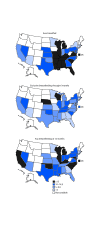Racial and Geographic Differences in Breastfeeding - United States, 2011-2015
- PMID: 28704352
- PMCID: PMC5687589
- DOI: 10.15585/mmwr.mm6627a3
Racial and Geographic Differences in Breastfeeding - United States, 2011-2015
Erratum in
-
Erratum: Vol. 66, No. 27.MMWR Morb Mortal Wkly Rep. 2017 Aug 4;66(27):815. doi: 10.15585/mmwr.mm6630a5. MMWR Morb Mortal Wkly Rep. 2017. PMID: 28771458 Free PMC article.
Abstract
Breastfeeding provides numerous health benefits for infants and mothers alike. The American Academy of Pediatrics recommends exclusive breastfeeding for approximately the first 6 months of life and continued breastfeeding with complementary foods through at least the first year (1). National estimates indicate substantial differences between non-Hispanic black (black) and non-Hispanic white (white) infants across breastfeeding indicators in the United States (2). CDC analyzed 2011-2015 National Immunization Survey (NIS) data for children born during 2010-2013 to describe breastfeeding initiation, exclusivity through 6 months and duration at 12 months among black and white infants. Among the 34 states (including the District of Columbia [DC]) with sufficient sample size (≥50 per group), initiation rates were significantly (p<0.05) lower among black infants than white infants in 23 states; in 14 of these states (primarily in the South and Midwest), the difference was at least 15 percentage points. A significant difference of at least 10 percentage points was identified in exclusive breastfeeding through 6 months in 12 states and in breastfeeding at 12 months in 22 states. Despite overall increases in breastfeeding rates for black and white infants over the last decade, racial disparities persist. Interventions specifically addressing barriers to breastfeeding for black women are needed.
Conflict of interest statement
Figures
References
-
- CDC. Breastfeeding among U.S. children born 2002–2013, CDC National Immunization Survey. Atlanta, GA: US Department of Health and Human Services, CDC; 2017. https://www.cdc.gov/breastfeeding/data/nis_data/index.htm
-
- CDC. Breastfeeding: NIS survey methods. Atlanta, GA: US Department of Health and Human Services, CDC; 2016. https://www.cdc.gov/breastfeeding/data/nis_data/survey_methods.htm
-
- Scanlon KS, Grummer-Strawn L, Li R, Chen J, Molinari N, Perrine CG. Racial and ethnic differences in breastfeeding initiation and duration, by state—National Immunization Survey, United States, 2004–2008. MMWR Morb Mortal Wkly Rep 2010;59:327–34. - PubMed
-
- US Department of Health and Human Services. The Surgeon General’s Call to Action to Support Breastfeeding. Washington, DC: US Department of Health and Human Services, Office of the Surgeon General, 2011.
MeSH terms
LinkOut - more resources
Full Text Sources
Other Literature Sources
Medical

